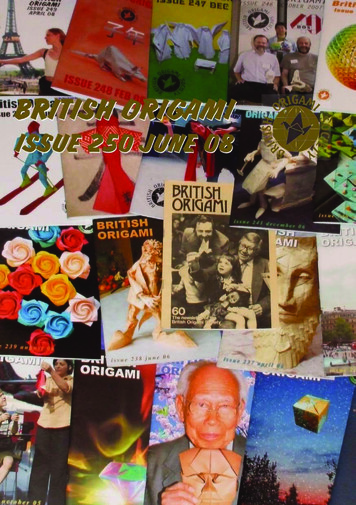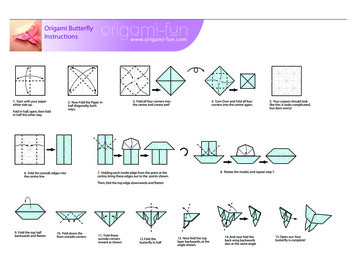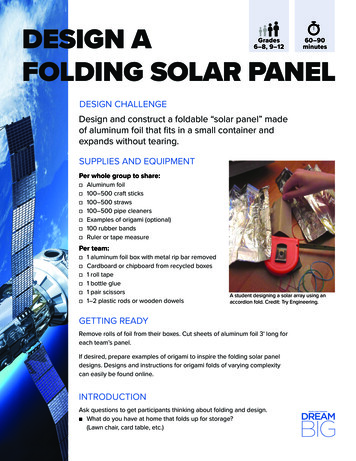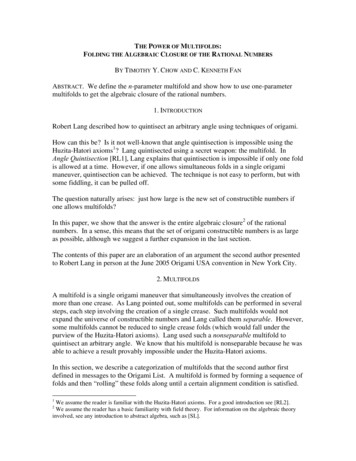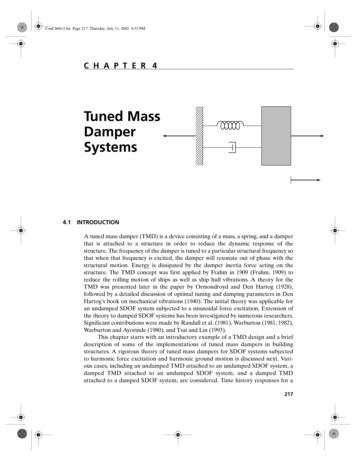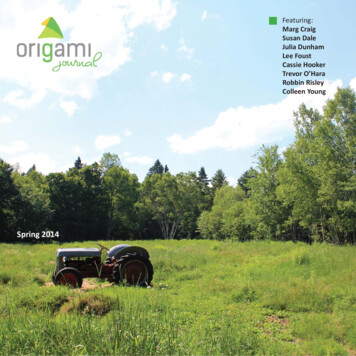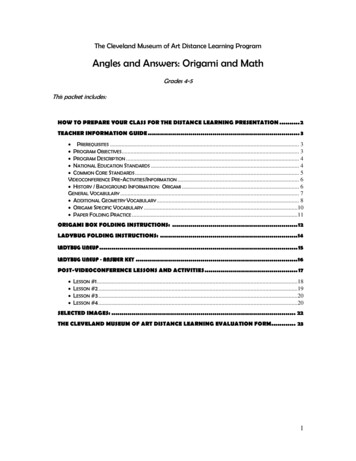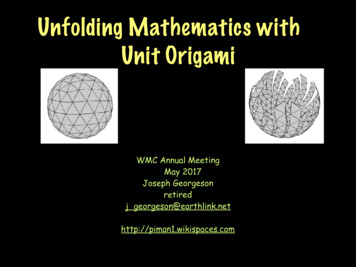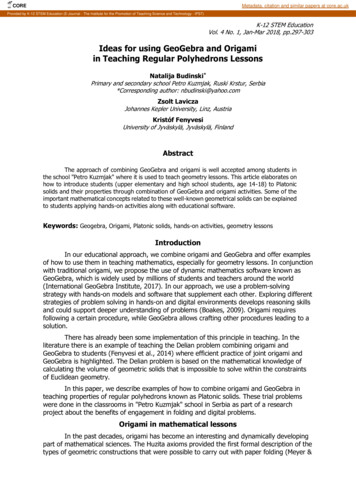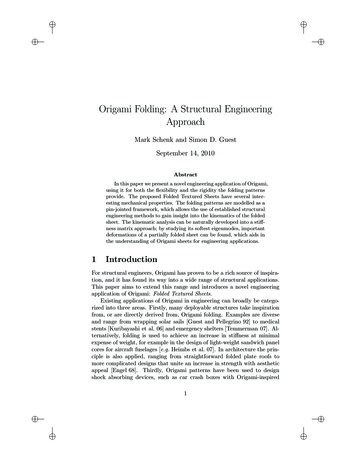
Transcription
iiiiOrigami Folding: A Structural EngineeringApproachMark Schenk and Simon D. GuestSeptember 14, 2010AbstractIn this paper we present a novel engineering application of Origami,using it for both the flexibility and the rigidity the folding patternsprovide. The proposed Folded Textured Sheets have several interesting mechanical properties. The folding patterns are modelled as apin-jointed framework, which allows the use of established structuralengineering methods to gain insight into the kinematics of the foldedsheet. The kinematic analysis can be naturally developed into a stiffness matrix approach; by studying its softest eigenmodes, importantdeformations of a partially folded sheet can be found, which aids inthe understanding of Origami sheets for engineering applications.1IntroductionFor structural engineers, Origami has proven to be a rich source of inspiration, and it has found its way into a wide range of structural applications.This paper aims to extend this range and introduces a novel engineeringapplication of Origami: Folded Textured Sheets.Existing applications of Origami in engineering can broadly be categorized into three areas. Firstly, many deployable structures take inspirationfrom, or are directly derived from, Origami folding. Examples are diverseand range from wrapping solar sails [Guest and Pellegrino 92] to medicalstents [Kuribayashi et al. 06] and emergency shelters [Temmerman 07]. Alternatively, folding is used to achieve an increase in stiffness at minimalexpense of weight, for example in the design of light-weight sandwich panelcores for aircraft fuselages [e.g. Heimbs et al. 07]. In architecture the principle is also applied, ranging from straightforward folded plate roofs tomore complicated designs that unite an increase in strength with aestheticappeal [Engel 68]. Thirdly, Origami patterns have been used to designshock absorbing devices, such as car crash boxes with Origami-inspired1iiii
iiiipatterns that induce higher local buckling modes [Weina and You 10], andpackaging materials [Basily and Elsayed 04].In contrast to existing engineering applications, the Folded TexturedSheets introduced in this paper use Origami for a different, and slightlyparadoxical, purpose: both for the flexibility and the stiffness that it provides. The Origami folding patterns enable the sheets to deform easily intosome deformation modes, whilst remaining stiff in others. This anisotropyin deformation modes is for example of interest for applications in morphing structures; these types of structures are capable of changing theirshape to accommodate new requirements, whilst maintaining a continuousexternal surface.1.1OutlineSection 2 introduces two example Folded Textured Sheets, the Eggboxand Miura sheet, and will highlight some of their mechanical properties ofinterest. Section 3 describes the mechanical model in detail, interleavedwith results for the two example sheets.2Folded Textured SheetsThe Folded Textured Sheets form part of ongoing research into the properties and applications of textured sheets. By introducing a ‘local’ texture (such as corrugations, dimples, folds, etc.) to otherwise isotropic thinwalled sheets, the ‘global’ mechanical properties of the sheets can be favourably modified. The ‘local’ texture has no clearly defined scale, butlies somewhere between the material and the structural level and in effectforms a microstructure. The texture patterns in Folded Textured Sheetsare inspired by Origami folding, as the resulting sheets need not necessarilybe developable. The texture consists of distinct fold lines, and it is therefore better to speak of polygonal faceted surfaces. See Figure 1 for the twoexample sheets used in this paper: the Eggbox and Miura sheet.The first obvious property of the folded sheets is their ability to undergorelatively large deformations, by virtue of the folds opening and closing.Moreover, the fold patterns enable the sheets to locally expand and contract — and thereby change their global Gaussian curvature — without anystretching at material level. Gaussian curvature is an intrinsic measure ofthe curvature at a point on a surface, which remains invariant when bending, but not stretching the surface [Huffman 76]. Our interest lies with themacroscopic behaviour of the sheets, and we therefore consider the ‘global’Gaussian curvature of an equivalent mid-surface of the folded sheet. Boththe Eggbox and Miura sheets are initially flat, and thus have a zero global2iiii
iiii(a) overview of folded textured sheets(b) close-up of unit cellsFigure 1: photographs of the Eggbox (left) and the Miura sheet (right).The models are made of standard printing paper, and the parallelograms inboth sheets have sides of 15mm and an acute angle of 60 . The Miura sheetis folded from a single flat sheet of paper; the Eggbox sheet, in contrast,is made by gluing together strips of paper, and has (equal and opposite)angular defects at its apices and saddle points.3iiii
iiiiGaussian curvature. Now, unlike conventional sheets, both folded texturedsheets can easily be twisted into a saddle-shaped configuration which hasa globally negative Gaussian curvature — see Figure 2(a) and Figure 3(a).The sheets’ most intriguing property, however, relates to their Poisson’sratio. Both sheets have a single in-plane mechanism whereby the facets donot bend and the folds behave as hinges; by contrast, facet bending isnecessary for the out-of-plane deformations. As shown in Figure 2(b) andFigure 3(b), the Eggbox and the Miura sheet respectively have a positiveand a negative Poisson’s ratio in their planar deformation mode. A negative Poisson’s ratio is fairly uncommon, but can for instance be found infoams with a reentrant microstructure [Lakes 87]. Conventionally, materials with a positive Poisson’s ratio will deform anticlastically under bending(i.e., into a saddle-shape) and materials with a negative Poisson’s ratio willdeform synclastically into a spherical shape. As illustrated in Figure 2(c)and Figure 3(c), however, both folded textured sheets behave exactly opposite to what is conventionally expected, and their Poisson’s ratio is ofopposite sign for in-plane stretching and out-of-plane bending. This remarkable mechanical behaviour has only been described theoretically forauxetic composite laminates [Lim 07] and specially machined chiral auxetics [Alderson et al. 10], but is here observed in textured sheets made ofconventional materials.2.1Engineering ApplicationsOur interest in the Folded Textured Sheets is diverse. Firstly, they canundergo large global deformations as a result of the opening and closingof the folds. Furthermore, these folds provide flexibility in certain deformation modes, whilst still providing an increased bending stiffness. Thiscombination of flexibility and rigidity is of interest in morphing structures,such as the skin of morphing aircraft wings [Thill et al. 08].Another interesting property of the folded sheets is their ability tochange their global Gaussian curvature, without stretching at materiallevel. This is of interest in architectural applications, where it may be usedas cladding material for doubly-curved surfaces, or, at a larger scale, as flexible façades. Furthermore, the use of the sheets as reusable doubly-curvedconcrete formwork is being explored; work is still ongoing to determine therange of surface curvatures that these sheets can attain.Applications for the remarkable behaviour of the oppositely signed Poisson’s ratios under bending and stretching are still being sought. Nevertheless, the folded sheets add a new category to the field of auxetic materials.4iiii
iiii(a)(b)(c)Figure 2: mechanical behaviour of the Eggbox sheet. Firstly, it can changeits global Gaussian curvature by twisting into a saddle-shaped configuration (a). Secondly, the Eggbox sheet displays a positive Poisson’s ratiounder extension (b), but deforms either into a cylindrical or a sphericalshape under bending (c). The spherical shape is conventionally seen inmaterials with a negative Poisson’s ratio.5iiii
iiii(a)(b)(c)Figure 3: mechanical behaviour of the Miura sheet; it can be twisted into asaddle-shaped configuration with a negative global Gaussian curvature (a).Secondly, the Miura sheet behaves as an auxetic material (negative Poisson’s ratio) in planar deformation (b), but it assumes a saddle-shaped configuration under bending (c), which is typical behaviour for materials witha positive Poisson’s ratio.6iiii
iiii3Mechanical Modelling MethodAvailable mechanical modelling methods for Origami folding broadly coverRigid Origami simulators [Tachi 06, Balkcom 04] or methods describingpaper as thin shells using Finite Elements. Our purpose is not to formulate an alternative method to describe rigid origami, as we aim to obtaindifferent information. Neither do we wish to use Finite Element Modelling,since we are not interested in the minutiae of the stress distributions, butrather the effect of the introduced geometry on the global properties ofthe sheet. The salient behaviour straddles kinematics and stiffness: thereare dominant mechanisms, but they have a non-zero stiffness. Our methodneeds to cover this behaviour. It should also not be limited to rigid origamias the out-of-plane kinematics of the sheets involves bending of the facets.Our approach is based on modelling the partially folded state of a foldedpattern as a pin-jointed truss framework. Each vertex in the folded sheetis represented by a pin-joint, and every fold line by a bar element. Additionally, the facets are triangulated to avoid trivial internal mechanisms, aswell as provide a first-order approximation to bending of the facets — seeFigure 4.Although the use of a pin-jointed bar framework to representOrigami folding has been hinted at on several occasions [e.g., Tachi 06,Watanabe and Kawaguchi 06], it has not been fully introduced into theOrigami literature. The method provides useful insights into the mechanical properties of a partially folded Origami sheet, and has the benefit ofan established and rich background literature.3.1Governing EquationsThe analysis of pin-jointed frameworks is well-established in structural mechanics. Its mechanical properties are described by three linearized equations: equilibrium, compatibility and material properties.At f(1)Cd e(2)Ge t(3)where A is the equilibrium matrix, which relates the internal bar tensionst to the applied nodal forces f ; the compatibility matrix C relates thenodal displacements d to the bar extensions e and the material equationintroduces the axial bar stiffnesses along the diagonal of G. It can beshown through a straightforward virtual work argument that C AT , thestatic-kinematic duality.7iiii
iiii3.2Kinematic AnalysisThe linear-elastic behaviour of the truss framework can now be described,by analysing the vector subspaces of the equilibrium and compatiblity matrices [Pellegrino and Calladine 86]. Of main interest in our case is thenullspace of the compatibility matrix, as it provides nodal displacementsthat — to first order — have no bar elongations: internal mechanisms.Cd 0These mechanisms may either be finite or infinitesimal, but in general theinformation from the nullspace analysis alone does not suffice to establish the difference. First-order infinitesimal mechanisms can be stabilisedby states of self-stress, and a full tangent stiffness matrix would have tobe formulated to take into account any geometric stiffness resulting fromreorientation of the members.In the case of the folded textured sheets, the nullspace of the conventional compatibility matrix does not provide much useful information: thetriangulated facets can easily ‘bend’, which is reflected by an equivalentnumber of trivial internal mechanisms. The solution is to introduce additional contraints. The compatibility matrix can be reformulated as theJacobian of the quadratic bar length constraints, with respect to the nodalcoordinates. This parallel can be used to introduce additional equalityconstraints to the bar framework. In our case we add a constraint on thedihedral angle between two adjoining facets.The angular constraint F is set up in terms of the dihedral fold angle θbetween two facets. Using vector analysis, the angle between two facets canbe described in terms of cross and inner products of the nodal coordinatesp of the two facets (see Figure 5):F sin (θ) sin (θ (p)) . . .(4)and the Jacobian becomesJ 1 X Fdpi dθcos (θ) pi(5)The Jacobian of additional constraints J can now be concatenated with theexisting compatibility matrix Ced (6)Jdθand the nullspace of this set of equations produces the nodal displacementsd that do not extend the bars, as well as not violate the angular constraints.In effect, we have formulated a rigid origami simulator — no bending or8iiii
iiiiKfoldKfacetFigure 4: Unit cell of the Eggbox sheet, illustrating the pin-jointed barframework model used to model the folded textured sheets. The facetshave been triangulated, to avoid trivial mechanisms and provide a firstorder approximation for the bending of the facets. Bending stiffness hasbeen added to the facets and fold lines, Kfacet and Kfold respectively.3 -θ1b2a4cFigure 5: The dihedral fold angle θ can be expressed in terms of the nodalcoordinates of the two adjoining facets. Using the vectors a, b and c,1the following expression holds: sin (θ) sin(γ)1sin(β) a 3 b c (a (c a)) ·(a b). Here γ is the angle between a and b, and β the angle between aand c.9iiii
iiii(a)(b)Figure 6: The Eggbox (a) and Miura (b) sheet both exhibit a single planar mechanism when the facets are not allowed to bend, as described inSection 3.2. The reference configuration is indicated as dashed lines.stretching of the facets is allowed. In order to track the motion of thefolded sheet, one iteratively follows the infinitesimal mechanisms whilstcorrecting for the errors using the Moore-Penrose
ciple is also applied, ranging from straightforward folded plate roofs to more complicated designs that unite an increase in strength with aesthetic appeal [Engel 68]. Thirdly, Origami patterns have been used to design shock absorbing devices, such as car crash boxes with Origami-inspired 1. i i i i i i i i patterns that induce higher local buckling modes [Weina and You 10], and packaging .
